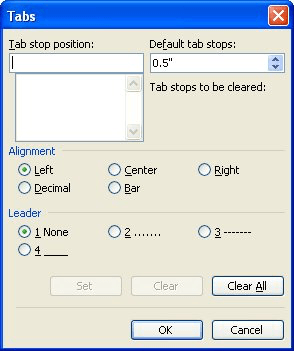Please Note: This article is written for users of the following Microsoft Word versions: 97, 2000, 2002, and 2003. If you are using a later version (Word 2007 or later), this tip may not work for you. For a version of this tip written specifically for later versions of Word, click here: Understanding Default Tab Stops.
Written by Allen Wyatt (last updated May 22, 2020)
This tip applies to Word 97, 2000, 2002, and 2003
Word has many different levels of formatting that you can do in a document. Some formatting settings apply to characters, others to paragraphs, still others to sections, and finally there are formatting settings that apply to the entire document.
We normally think of tab stops as being a "paragraph-level setting." However, there is one tab stop option that applies to the entire document, not just to a particular paragraph. The way in which the setting is presented in Word is a bit deceiving, however.
The setting in mind, of course, is for the default tab stop distance. There is a single default tab stop distance that you can set in Word, although you do it from the Tabs dialog box, which is definitely a paragraph-level formatting dialog box. To see what this means, position your insertion point anywhere within your document; it doesn't matter where. Then choose Tabs from the Format menu. You will see the Tabs dialog box. (See Figure 1.)

Figure 1. The Tabs dialog box.
In the upper-right corner of the dialog box is the Default Tab Stops value. This value applies to the entire document, even though every other setting in the dialog box applies only to the current paragraph.
To test this out, change the Default Tab Stops value to something different from what it is, then click on OK. The dialog box closes, and the default is changed. Now, position the insertion point somewhere else in the document and again choose Tabs from the Format menu. The Default Tab Stops value should still be set to the new value you entered.
This means that to permanently change (so to speak) the default tab stop value, you need to do it within the templates you use to create new documents. For instance, you would follow these general steps to change the default tab stops in Normal.Dot:
Once these steps are complete, then all new documents based on Normal.Dot will have the default tab stops set the way you want them. (Notice that this is for all new documents; existing documents will still have the old default tab setting. They will have to be changed individually.)
WordTips is your source for cost-effective Microsoft Word training. (Microsoft Word is the most popular word processing software in the world.) This tip (1187) applies to Microsoft Word 97, 2000, 2002, and 2003. You can find a version of this tip for the ribbon interface of Word (Word 2007 and later) here: Understanding Default Tab Stops.

Do More in Less Time! An easy-to-understand guide to the more advanced features available in the Microsoft 365 version of Word. Enhance the quality of your documents and boost productivity in any field with this in-depth resource. Complete your Word-related tasks more efficiently as you unlock lesser-known tools and learn to quickly access the features you need. Check out Microsoft 365 Word For Professionals For Dummies today!
Tab stops can be helpful when you want to align text within a paragraph. However, you might also want an easy way to get ...
Discover MoreTabs don't normally show up in your printed document, but Word allows you to still search for them. All you need to do is ...
Discover MoreTab stops allow you to modify the horizontal position at which text is positioned on a line. If you want to get rid of ...
Discover MoreFREE SERVICE: Get tips like this every week in WordTips, a free productivity newsletter. Enter your address and click "Subscribe."
2016-04-25 08:08:13
shanaya
i am confused i want to know the different between tab stop position and default tab position help me if u can ??
Got a version of Word that uses the menu interface (Word 97, Word 2000, Word 2002, or Word 2003)? This site is for you! If you use a later version of Word, visit our WordTips site focusing on the ribbon interface.
Visit the WordTips channel on YouTube
FREE SERVICE: Get tips like this every week in WordTips, a free productivity newsletter. Enter your address and click "Subscribe."
Copyright © 2026 Sharon Parq Associates, Inc.
Comments